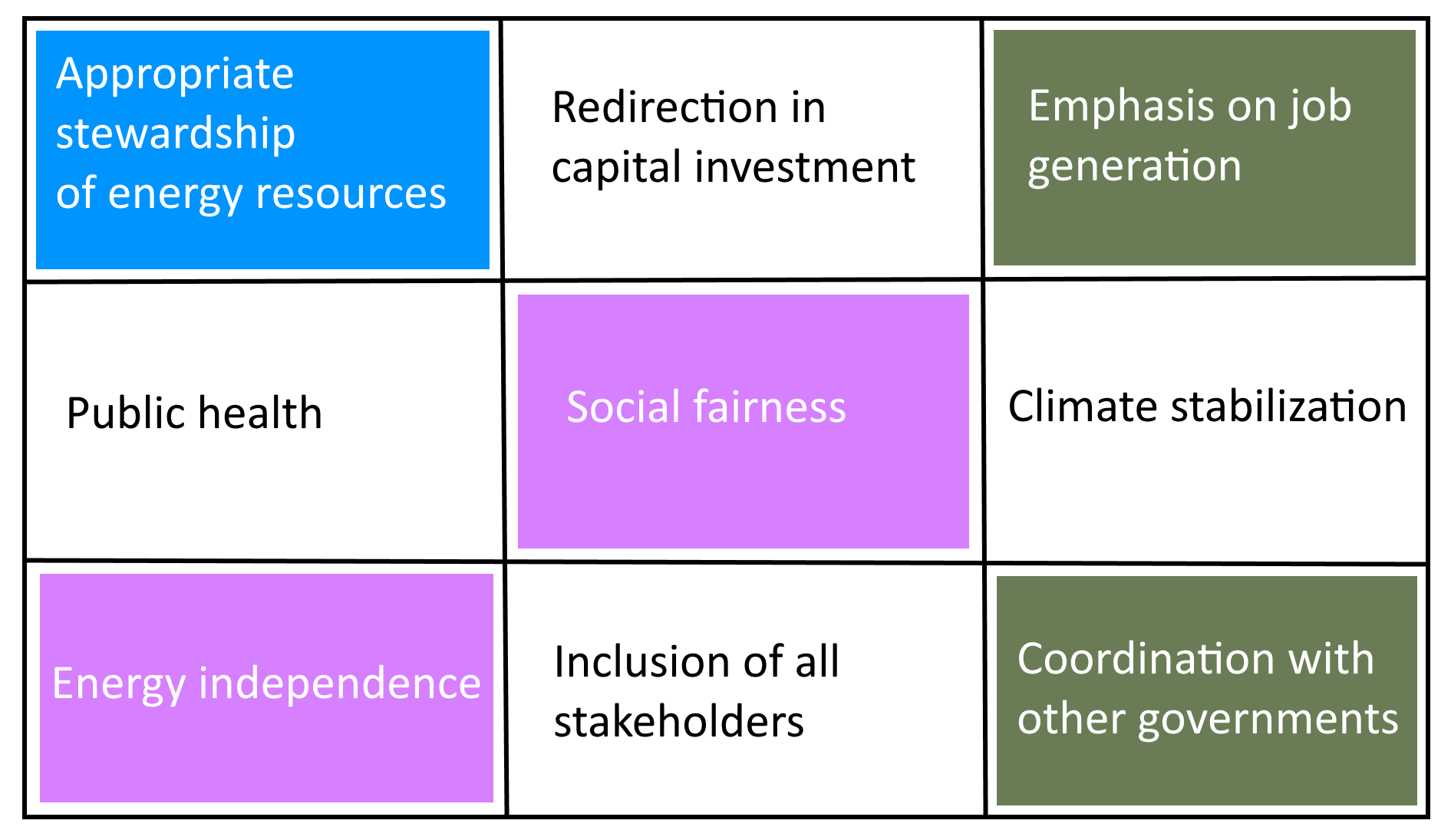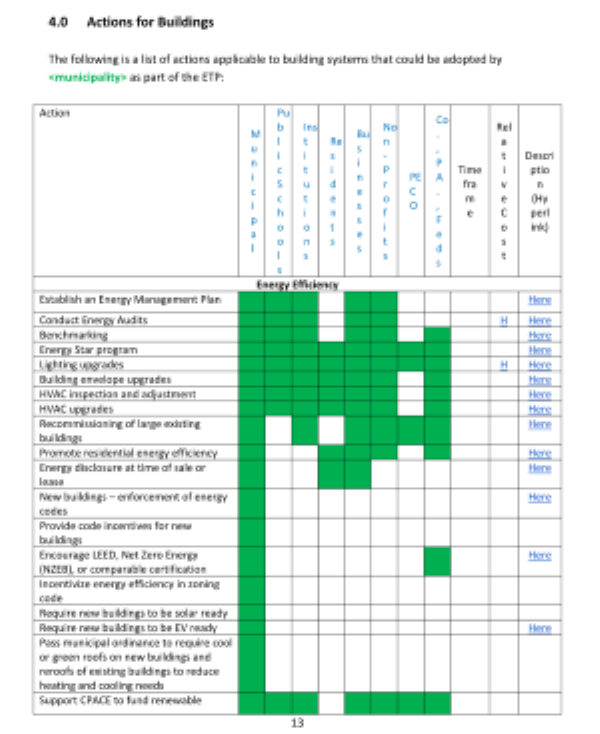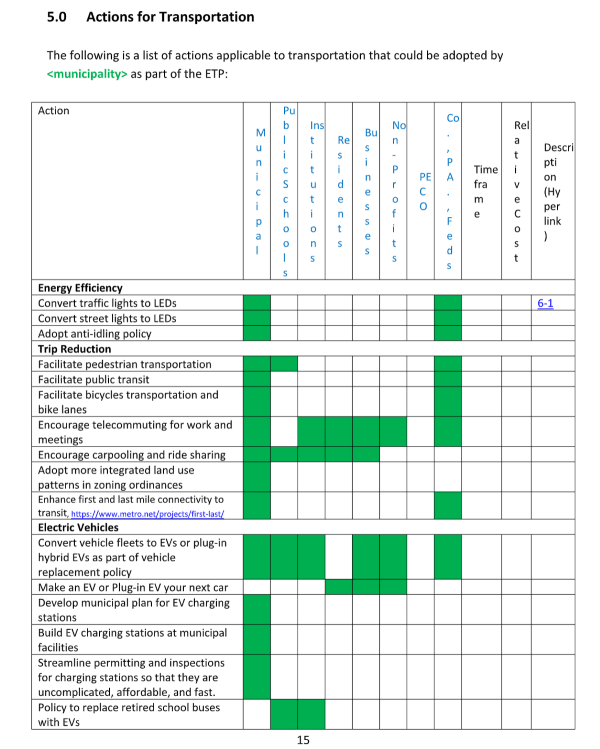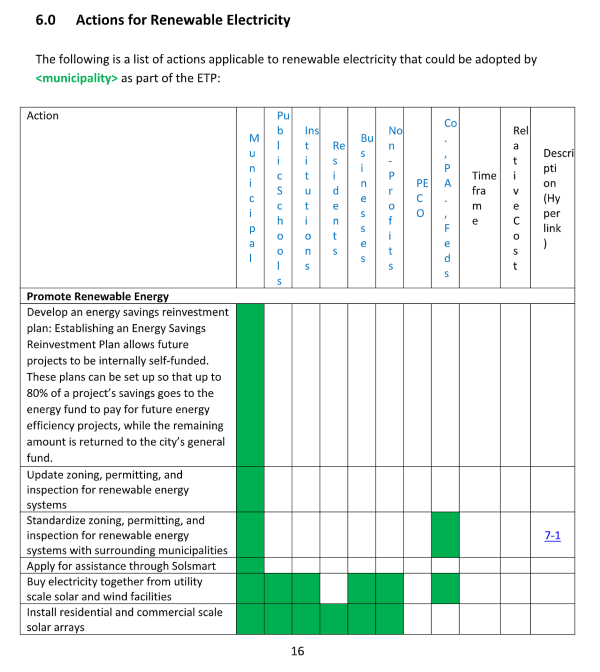Clean Energy Transition Plan
Template
The Energy Transition Plan template that was developed by local Ready for 100 volunteers is a generic plan to achieve the reduction of greenhouse gas (GHG) emissions at a rate and in a time period that will prevent climate change to an extent that will cause major disruption of our society. A significant supplementary benefit is the reduction of air pollution and the elimination of the environmental impacts on land and water from the extraction and processing of fossil fuels. An Energy Transition Plan is the major component of a Climate Action Plan (CAP). They both seek to reduce energy usage through energy efficiency measure because that is the most cost-effective way of reducing carbon emissions. And they both seek the electrification of buildings, which would otherwise be heated by combustion sources. They both seek to replace fossil fuel sources of energy with renewable energy. Finally, both discuss the role of waste management in reducing emissions of GHGs. The draft Chester County CAP is virtually identical in subject matter and content to the Energy Transition Plan template.
The Energy Transition Plan template was prepared by taking the best of the plans around the country (none of which are Sierra Club plans) and synthesizing a generic plan for the municipalities in the five-county southeastern Pennsylvania area. It provides a download of the emission inventory for each municipality developed by the Delaware Valley Regional Planning Commission (DVRPC). This template provides a starting point for the municipal planning process and the implementation of actions to reduce GHG emissions in concert with the municipal and county comprehensive plans.
Use this template as a starting point for developing a customized energy transition plan for your municipality or group of municipalities.
Download Google Doc version HERE
Download PDF version HERE
Synopsis of the Energy Transition Plan
1.0 Introduction
This Energy Transition Plan (ETP) addresses the challenges and opportunities of the coming decades related to public and private investment, jobs creation, public health concerns, energy reliability and independence, and climate disruption as it applies to our current energy consumption patterns. The ETP recommends changes that will support <municipality> and its residents, businesses and other community stakeholders in recognizing the breadth of these challenges and then pursuing the steps outlined to enhance the economic, social and environmental foundations of the community, and by extension the region, state, nation and the world.
2.0 Statement of Purpose
The following are the guiding principles and goals of this Energy Transition Plan, which provide an integrated approach for planning and actions:

3.0 Plan Implementation
This section provides information on energy usage and expenditures and emissions of greenhouse gases within the municipality and discusses how the plan is to be implemented and by whom. This plan has been prepared and will be implemented pursuant to the direction of <municipality's>; Resolution, which calls for the transition to renewable energy for all purposes by 2050.
3.1 Establishing A Leadership Team
This section discusses guidelines for forming a steering committee, collecting information about current energy and greenhouse gas footprints and suggestions for the development of the plan itself - customizing this template.

3.2 Identification and Engagement with Community Groups
This section lists the stakeholders within the community, the ways in which they can be important participants in this plan, and the talents they bring to the transition to renewable energy. It would be useful for the steering committee to identify those in the community that have their own clean energy targets, efficiency programs, renewable energy systems, renewable electricity power purchase agreements, and replacement policies which take a transition to clean energy into account.

3.3 Public Input and Engagement With Stakeholders
Public input is a valuable dimension to the overall planning and implementation. One or more visioning sessions should be held to ensure the stakeholders in the community have an opportunity to provide input and to voice concerns. Stakeholders include businesses, schools, healthcare centers, commuters, residents - anyone that will be a consumer of energy and anyone that may be impacted by the decisions made to transition to renewable energy.

 4.0 Action For Buildings
4.0 Action For Buildings
The following is a list of actions applicable to building systems (e.g. energy audits and benchmarking, solar readiness, lighting upgrades) that could be adopted by <municipality> as part of the ETP.
5.0 Actions For Transportation
The following is a list of actions applicable to transportation (e.g. traffic and streetlighting, trip reduction strategies, EV charging infrastructure) that could be adopted by
<municipality> as part of the ETP:
 6.0 Actions For Renewable Electricity
6.0 Actions For Renewable Electricity
The following is a list of actions applicable to renewable electricity (e.g. energy savings reinvestment plans, SolSmart, zoning and permiting) that could be adopted by
<municipality> as part of the ETP:
7.0 Actions For Waste Management
The following is a list of actions applicable to waste management that could be adopted by
<municipality> as part of the ETP:
8.0 Summation Of Actions Implemented
A living checklist of actions taken and assessment of impact is used to inform future revisions of this plan and prioritization of recommended actions.
9.0 Useful References
Links to information energy transition planning in General, on Buildings, Transportation and Waste Management
Apendix A
A.0 Information for Achieving Energy Transition
A.1 Information on Energy Usage and Expenditures and GHG Emissions
A.2 Strategies for Energy Transition and GHG Emission Reductions